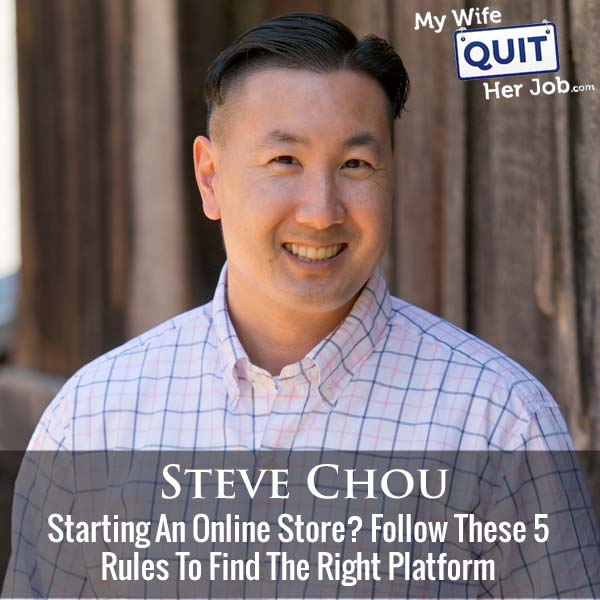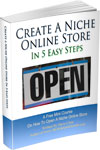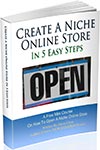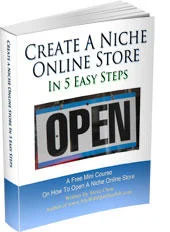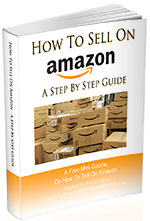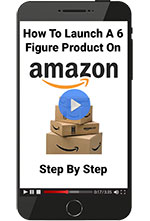Podcast: Download (Duration: 13:06 — 15.3MB)
In this episode, I answer the top question that I always get asked. Which ecommerce platform should you use for your online store?
Unfortunately, the answer isn’t black and white. So in this episode, I’ll help you figure it all out.
Get My Free Mini Course On How To Start A Successful Ecommerce Store
If you are interested in starting an ecommerce business, I put together a comprehensive package of resources that will help you launch your own online store from complete scratch. Be sure to grab it before you leave!
What You’ll Learn
- Your ecommerce platform options
- How to choose the right problem
- Five essential rules when starting an online store
Other Resources And Books
Sponsors
SellersSummit.com – The Sellers Summit is the ecommerce conference that I’ve run for the past 8 years. It’s small and intimate and you’ll learn a ton! Click Here To Grab Your Ticket.
The Family First Entrepreneur – Purchase my Wall Street Journal Bestselling book and receive $690 in free bonuses! Click here to redeem the bonuses
Transcript
You’re listening to the My Wife, Quarter, Job podcast, the place where I bring on successful bootstrap business owners and delve deeply into what strategies are working and what strategies are not with their businesses. today I’m doing a solo episode to answer once and for all, probably the top question that I get asked, which e-commerce platform should I use for my online store? And the answer isn’t black and white. So in this episode, I’m going to ask you a series of questions to help you figure it all out. But before we begin, I wanted to let you know that tickets for the 2024 Seller Summit,
00:28
are now on sale over at SellersSummit.com. The Seller Summit is the conference that I hold every year that specifically targets e-commerce entrepreneurs selling physical products online. And unlike other events that focus on inspirational stories and high-level BS, mine is a curriculum-based conference where you will leave with practical and actionable strategies specifically for an e-commerce business. Every speaker I invite is deep in the trenches of their business, entrepreneurs who are importing large quantities of physical goods,
00:55
and not some high level guys who are overseeing their companies at 50,000 feet. Now I personally hate large events, so the Seller Summit is always small and intimate. Every year we cut out ticket sales at around 200 people, so tickets sell out fast and we’ve sold out every single year for the past eight years. Now if you’re an e-commerce entrepreneur making over 250k or $1 million per year, we also offer an exclusive mastermind experience with other top sellers. The Seller Summit is going to be held in Fort Lauderdale, Florida from May 14th May 16th
01:25
And right now, this is the cheapest the tickets will ever be. Also, if you haven’t picked up my Wall Street Journal bestselling book, The Family First Entrepreneur yet, it’s actually available on Amazon at 38 % off. My book will teach you how to achieve financial freedom by starting a business that does not require you to work yourself to death. Plus, you can still grab my free bonus workshop on how to sell on print on demand and how to make passive income with blogging, YouTube and podcasting when you grab the book over at mywifequitterjob.com slash book.
01:54
So go over to mywifequitterjob.com slash book, fill out the form and you’ll get the bonuses right away. Now onto the show.
02:07
Welcome to the MyWifeCoderJob podcast. Now, if you’re an entrepreneur thinking about starting your own online store or e-commerce business, one of the most crucial decisions you’ll have to make is choosing the right e-commerce platform. And it’s a decision that can significantly impact the success of your business. But with so many options out there, it can be incredibly overwhelming to choose the right one. But I’ve got your back because today I’m going to share with you the five essential rules that you need to consider when choosing the right e-commerce platform that matches your personality and your budget.
02:37
And these rules are tried and tested and have helped me and many of the students in my class to build successful online stores. So grab a notepad and let’s dive right in. As I mentioned earlier, the number one question I get asked nearly every day is which shopping cart to go with. And I just want to start this episode by sharing my own personal story on why this decision matters and why it’s important that you listen to the five rules that I’m about to teach you. I started my online store back in 2007 before Shopify existed, before Big Commerce, before Shift for Shop.
03:07
before WooCommerce and even before Amazon. As a result, I went with one of the only solutions that was available back in the day called OS Commerce. Now there were other options, but I chose OS Commerce because it was the best open-source shopping cart back in the day and best of all, it was free to use. OS Commerce ran great for me for a very long time, costing me only $7 a month and made me millions of dollars until one day, the main developers behind the project decided to stop developing for it.
03:36
And all of a sudden, I was left with a platform that was dead in the water with no more improvements ever again. But by then, I had invested so much time and wrote so much custom code for my online store that I had to choose whether to migrate my store to a cart like Shopify or BigCommerce or stick with my obsolete cart and maintain it myself. Now, ultimately, I made the tough decision to maintain my online store myself because the pain of migrating was just too great.
04:02
and it would be impossible to move over all the functionality that I had custom coded over the years. So guess what I had to do the other month? I literally spent 16 hours upgrading my online store to the latest and greatest software versions by myself. Now the one saving grace is that I only had to do this once every five years, and I’ve saved a ton of money over the years because my cart is 100 % free. But my point is, is that most of you listening to this episode probably do not have the technical chops to maintain the code for your website,
04:31
in case a company decides to go belly up. So for all of you listening, choosing the right e-commerce platform is extremely important because it is a major pain in the butt to switch. And with that, let’s start with rule number one. You should only use a shopping cart that is maintained by a well-known and well-supported company with a huge war chest of cash. In other words, if you’re thinking about using some unknown podunk e-commerce platform from some startup company, do not do it. Every now and then, a subscriber will email me
05:00
whether they should consider using some random free shopping cart that I’ve never heard of. And when I visit the website or company, it’s basically run by a two-person team running it as a side business. Do not do this. If you go with a well-known company, preferably a public company, then you can rest assured that your platform is going to be pretty safe. Even if the public company were to go bankrupt, someone would probably buy them and continue to support your store, giving you time to migrate to a different option. Now, the only exception to this rule
05:29
is if you go with the popular open source e-commerce platform with tons of developer support. For example, Linux is open source and it’s maintained by thousands of developers all over the world. If you obey this rule, it already narrows down your pool of choices to Shopify, BigCommerce, Shift4Shop, Square, Wix, Equid, Squarespace, WooCommerce, and Magento. Now, it’s still a large list, but at least you know the company will be around next year. Rule number two is that the shopping cart must have excellent third-party developer support.
05:58
Now I’m going to make the assumption here that most of you listening are not tech savvy and do not have the knowledge or the drive to create your own plugins or design your own website themes. Now you want to have an e-commerce platform that stands the test of time and evolves as the e-commerce landscape changes, that means that you’ll likely have to add new features to your online store at some point in your business’s lifetime. For example, in the not too distant future, it’ll probably be the norm to have an AI assistant help customers shop online.
06:27
And right now, your online store platform probably does not have this feature, so you’ll likely need to buy a plugin to implement it. But here’s the thing, developers only develop for the most popular platforms. If you look at the overall market share of shopping carts in the US, you’ll see that Shopify is number one, followed by WooCommerce, Wix, Squarespace, and Equid. But we all know that many of these shops don’t make any money at all, so let’s focus on the top online stores. If we look at the top one million websites in the world by web traffic,
06:57
it paints a completely different picture. The top websites in the world are on WooCommerce and Shopify, with Magento and BigCommerce on the radar screen as well. Now because Shopify and WooCommerce are by far the most popular shopping carts in the world, they command the most developer support. And as a result, any new e-commerce functionality will be created for these platforms first. So once again, if you want to future-proof your business, you’ll want to go with a well-supported shopping cart.
07:24
And this pretty much eliminates a lot of the bigger players who don’t have a large market share in the e-commerce space. People always ask me about Wix, Square, Squarespace, GoDaddy, Big Cartel. And my answer is that no developers are making any new software for these platforms. So even if they are backed by large companies, there really is no support except for the company itself. The most well-supported cards are Shopify, WooCommerce, BigCommerce, and Magento. Rule number three is that the e-commerce platform should be easy to maintain.
07:54
Now reason I have this rule in place is because most of you listening probably just want your online store software to just work and not have to worry about your website crashing or having to upgrade anything by yourself. Now if you want to follow this rule, you should probably rule out WooCommerce. Even though WooCommerce is 100 % free, you still have to have a server to run your website. And WooCommerce is based on open source software, which means that you own the source code for your website and you have full control over it. However, you still have to maintain the server that it runs on.
08:24
And this basically means that you have to upgrade all your own plugins and software, and you have to lock down your server in case anyone ever tries to hack you. Now, fortunately, WooCommerce and WordPress have a fairly robust push button upgrade mechanism, but bad things do happen from time to time. For example, a couple of weeks ago, I upgraded my WordPress blog for Bumblebee linens to the latest and greatest version, and a bunch of my plugins broke, and I had to manually debug what was wrong. Now, the primary benefit of going with a popular cart like WooCommerce
08:53
is that you can easily find help online on the forums, Reddit, Stack Overflow, et cetera. But ultimately, it is up to you to find your own solutions and fix the problems yourself. The other benefit of owning the source code is that you can easily create custom functionality for your website that goes way beyond what any plugin can do. For example, I sell personalized products in my shop. If I wanted to create a feature that allows customers to see a mock-up of the finished product before personalization, there’s no really any plugin that does that.
09:22
You’d have to write it yourself and WooCommerce allows you that flexibility. Anyway, if you have no desire to maintain your own software or server, that pretty much limits your choices at this point to BigCommerce or Shopify. Rule number four is that your e-commerce platform has to be reasonably priced and not cost you a large percentage of your revenue. Now, so far, I haven’t really said anything negative about Shopify, but one of the biggest negatives of Shopify is the price. Now, you might be thinking to yourself, $30 a month doesn’t sound that bad.
09:52
but that price is deceptive. Shopify was designed to have minimal functionality out of the box and they force you to pay for plugins to add features to your shopping cart. The average Shopify store uses seven plugins that charge recurring revenue. The typical Shopify user in my Create a Profitable Online Store course spends around $200 a month on Shopify. Meanwhile, other solutions like BigCommerce, Shift4Shop, and WooCommerce are way cheaper.
10:18
Bigcommerce has most of the functionality that you need out of the box so you don’t get nickel and dimed on apps. Shift for Shop is on this list because the shopping cart is as powerful as Bigcommerce and Shopify, and it’s 100 % free if you process at least $500 in orders every month. And WooCommerce is 100 % free to use, and WordPress has a library of thousands of free plugins to use for it. So if price is one of your primary concerns, then go with WooCommerce, Shift for Shop, or Bigcommerce because they will be cheaper.
10:47
And then finally we have rule number five, which is to choose an e-commerce platform with a good blogging platform that is optimized for search. Now this last rule is only important if ranking and search is an important criteria, and unfortunately, Shopify does not offer a very good blogging platform. Not only is Shopify’s blogging platform limited, but they have a suboptimal URL structure that is less conducive to ranking and search. Now of the choices that I’ve presented so far,
11:14
WooCommerce easily has the best blogging platform because it’s based on WordPress. And BigCommerce offers a cool plugin that integrates with WordPress so you can seamlessly run your blog on WordPress and your store on BigCommerce under the exact same subdomain. So basically, if blogging is important to you, then WooCommerce or BigCommerce are better solutions than Shopify. Now this point, I’ve probably fried your brain with a number of options, so let’s put everything together in a concise manner. If you have the budget,
11:42
and you don’t really care about costs, then Shopify is probably going to be your best option. Even though Shopify will nickel and dime you with apps and payment processing, it’s the best choice not necessarily because the platform itself is better, but because it is the best third-party developer ecosystem. Go with e-commerce if you want an overall solid shopping cart and great out-of-the-box functionality without getting nickel and dime with apps. If you want a strict budget, then go with WooCommerce or Shift for Shop.
12:10
WooCommerce offers you the most flexibility out of all the shopping carts listed because you have control over the source code. But you have to be tech savvy to maintain it. And finally, Shift4Shop is a great all-around shopping cart that is free when you make over $500 a month, which is a really low bar. So overall, I hope you enjoyed this episode and it should help you figure out which platform is best for you. And for more information about this episode and links to all the choices that I talked about on this episode, go to mywifequitteredop.com slash episode 510.
12:40
And once again, tickets to the Seller Summit 2024 are now on sale over at sellersummit.com. If you ever want to hang out in person in a small intimate setting, develop real relationships with like-minded entrepreneurs and learn a ton, then come to my event. Go to sellersummit.com. And if you are interested in starting your own e-commerce store, head on over to mywifequitterjob.com and sign up for my free six-day mini course. Just type in your email and I’ll send you the course right away. Thanks for listening.
I Need Your Help
If you enjoyed listening to this podcast, then please support me with a review on Apple Podcasts. It's easy and takes 1 minute! Just click here to head to Apple Podcasts and leave an honest rating and review of the podcast. Every review helps!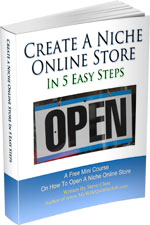
Ready To Get Serious About Starting An Online Business?
If you are really considering starting your own online business, then you have to check out my free mini course on How To Create A Niche Online Store In 5 Easy Steps.
In this 6 day mini course, I reveal the steps that my wife and I took to earn 100 thousand dollars in the span of just a year. Best of all, it's absolutely free!


